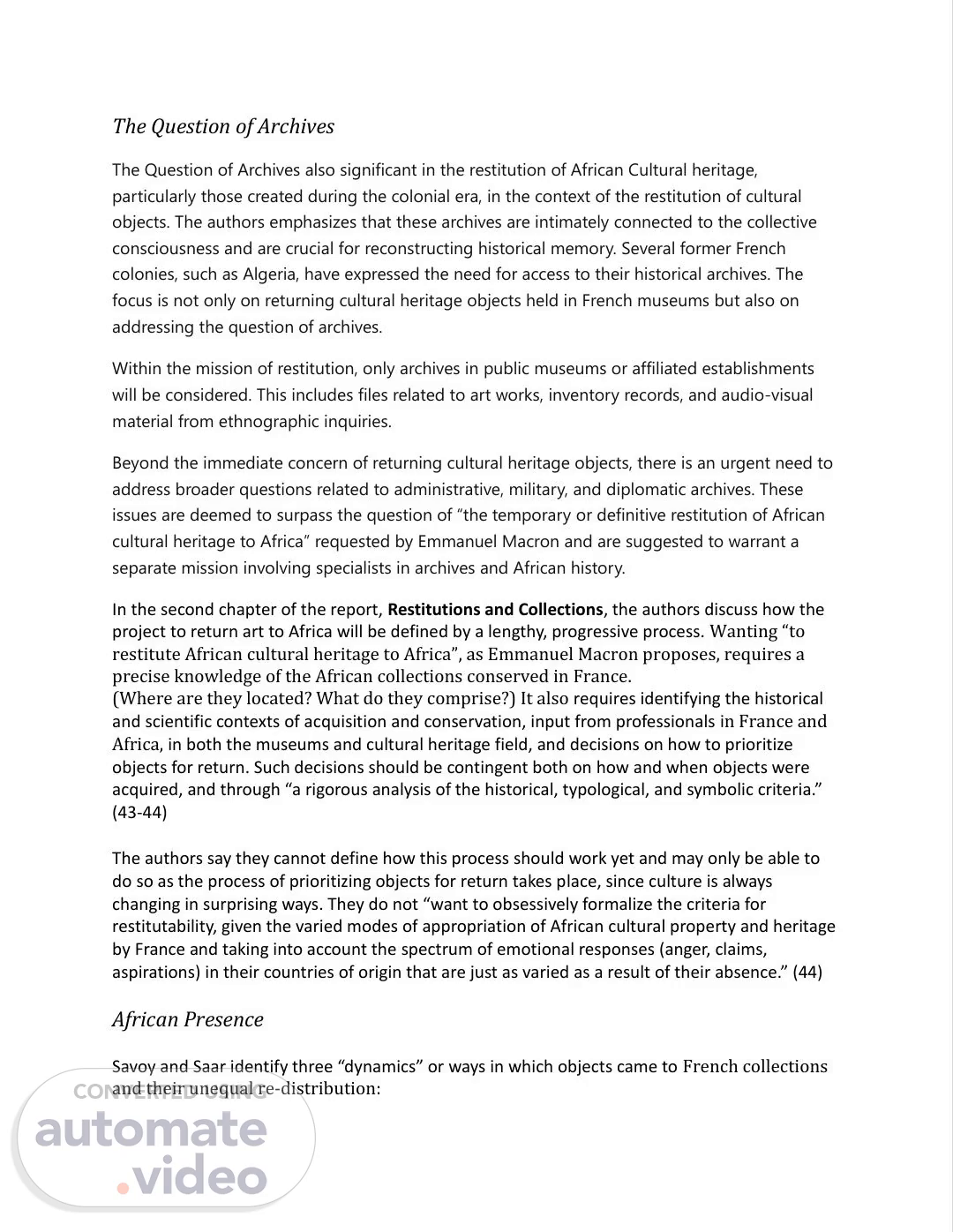
EU-History-Presentation
Scene 1 (0s)
The Question of Archives The Question of Archives also significant in the restitution of African Cultural heritage, particularly those created during the colonial era, in the context of the restitution of cultural objects. The authors emphasizes that these archives are intimately connected to the collective consciousness and are crucial for reconstructing historical memory. Several former French colonies, such as Algeria, have expressed the need for access to their historical archives. The focus is not only on returning cultural heritage objects held in French museums but also on addressing the question of archives. Within the mission of restitution, only archives in public museums or affiliated establishments will be considered. This includes files related to art works, inventory records, and audio-visual material from ethnographic inquiries. Beyond the immediate concern of returning cultural heritage objects, there is an urgent need to address broader questions related to administrative, military, and diplomatic archives. These issues are deemed to surpass the question of “the temporary or definitive restitution of African cultural heritage to Africa” requested by Emmanuel Macron and are suggested to warrant a separate mission involving specialists in archives and African history. In the second chapter of the report, Restitutions and Collections, the authors discuss how the project to return art to Africa will be defined by a lengthy, progressive process. Wanting “to restitute African cultural heritage to Africa”, as Emmanuel Macron proposes, requires a precise knowledge of the African collections conserved in France. (Where are they located? What do they comprise?) It also requires identifying the historical and scientific contexts of acquisition and conservation, input from professionals in France and Africa, in both the museums and cultural heritage field, and decisions on how to prioritize objects for return. Such decisions should be contingent both on how and when objects were acquired, and through “a rigorous analysis of the historical, typological, and symbolic criteria.” (43-44) The authors say they cannot define how this process should work yet and may only be able to do so as the process of prioritizing objects for return takes place, since culture is always changing in surprising ways. They do not “want to obsessively formalize the criteria for restitutability, given the varied modes of appropriation of African cultural property and heritage by France and taking into account the spectrum of emotional responses (anger, claims, aspirations) in their countries of origin that are just as varied as a result of their absence.” (44) African Presence Savoy and Saar identify three “dynamics” or ways in which objects came to French collections and their unequal re-distribution:.
Scene 2 (1m 5s)
1. A state dynamics, since the French revolution and a dual logic of national affirmation and international competition, pushing France toward a “hyper-centralization” in Paris of the collections of cultural heritage judged to be the most important.” 2. A “flow dynamic,” resulting in collections of African objects in French coastal cities involved with mercantile trade with Africa as the arrival points for mercantile boats or military vessels 3. Objects obtained through inheritance, gifts, records, and donations. They note that there is no single source documenting the objects in all French collections, and many smaller collections are not well documented. (45) Therefore, restitutions will have to draw on the well-documented collections of “70,000 items from sub-Saharan Africa housed in the Musee du quai Branly-Jacques Chirac.” They note that the museum also has 90,000 related documents (photographs, graphic art, drawings, post cards, posters, stamps…) that might also be sent to Africa but are not clear how that process will work. (46) Which Africa for which Restitutions? There are larger number of objects in the collections of the Musee du quai Branly-Jacques Chirac from former French colonies in Africa. (46) Chad (9,296 objects) Cameroon (7,838 Madagascar (7,590) Mali (6,910) Ivory Coast (3,951) Benin (3,157), Republic of the Congo (2,593) Gabon (2,448) Senegal (2,281) Guinea (1,997). Ethiopia (3,081 pieces) Ghana (1,656) Nigeria (1,148) Democratic Republic of the Congo (1,428) Southern Africa (1,692 without Madagascar) East Africa (5,343) The information suggests a convergence between the geography of French colonies in Africa and the African collections in the Musée du quai Branly-Jacques Chirac, indicating a need to consider the relationship between colonial law and cultural heritage extraction. It raises questions about whether there was consent from the countries of origin during the acquisition and removal of objects to mainland France. Objects from non-colonized countries like Ethiopia, the Democratic Republic of the Congo, Nigeria, and Ghana are highlighted as an important group, with these countries actively seeking restitution since gaining independence in the 1960s. The suggestion is that objects from these countries should receive equal attention in the restitution process as those from former French colonies..
Scene 3 (2m 10s)
To understand the mechanisms behind France's acquisition of these objects, the proposal includes a call for a chronological analysis of acquisitions to determine if there were notable increases in collections before and after colonization took place, aiming to assess the legitimacy of acquisitions across different eras, including the present. What History do we want to revisit? The authors consider how certain time periods correspond to entry of African objects into museums, a period “prior to the Berlin conference that sealed the agreement between the European powers (1884/1885) on how they planned to divide up their control of Africa. The second moment covers the colonial period up until the independence of nations (1960). The third moment began in the 1960s,” (47) and represents an “influx of legally commercial objects bearing an illicit origin”. (49) (It appears that “legally commercial objects bearing an illicit origin” are objects that were legally imported into France and legally sold under French law, but which will be deemed “illicit” for the purpose of restitution if they were exported without explicit permission from the countries of origin or purchased without what might be called “informed consent” from their original owners..